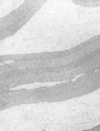Molecular Pathogenesis
Corneal transparency requires that collagen fibrils be properly organized with a uniform diameter and a regular interfibrillar space. Congenital stromal corneal dystrophy (CSCD) is characterized by stromal opacities throughout the cornea. By transmission electron microscopy these opacities are seen as layers of amorphous material with thin filaments. The reported DCN pathogenic variants all lead to formation of a truncated decorin that has a tendency to aggregate in vitro. Decorin is found to accumulate in the amorphous areas. The authors hypothesize that truncated decorin accumulates in CSCD, thus causing the opacities [Bredrup et al 2010]. Studies in mice have shown that extracellular export of truncated decorin is necessary for the development of corneal opacities [Mellgren et al 2015].
Gene structure.
DCN spans 3,777 kb. The full-length gene consists of eight exons with the AUG start codon in exon 2. For a detailed summary of gene and protein information, see Table A, Gene.
Benign variants. An imperfect dinucleotide repeat variation is in intron 1. In a small cohort of individuals with type 1 diabetes, one of these variants was associated with slower progression of renal disease [De Cosmo et al 2002] (see Table A, HGMD).
Pathogenic variants. Four variants associated with CSCD have been detected in DCN (Table 3) [Bredrup et al 2005, Rødahl et al 2006, Kim et al 2011, Jing et al 2014]. They are all frameshift variants located in the last coding exon. The resulting proteins are predicted to have a few altered terminal amino acid residues and a deletion of the 33 C-terminal amino acids.
Lee et al [2012] have reported a c.1036T>G (p.Cys346Gly) variant in a family where affected individuals developed corneal opacities in adult life. The functional consequences of this variant at the protein level have not yet been studied. The authors suggest that this could represent a mild form of CSCD.
Table 3.
DCN Pathogenic Variants Discussed in This GeneReview
View in own window
| DNA Nucleotide Change | Predicted Protein Change | Reference Sequences |
|---|
| c.1036T>G | p.Cys346Gly |
NM_001920.3
NP_001911.1
|
| c.967delT | p.Ser323LeufsTer5 |
| c.941delC | p.Pro314HisfsTer14 |
| c.947delG | p.Gly316AspfsTer12 |
| c.962delA | p.Lys321ArgfsTer7 |
Variants listed in the table have been provided by the authors. GeneReviews staff have not independently verified the classification of variants.
GeneReviews follows the standard naming conventions of the Human Genome Variation Society (varnomen.hgvs.org). See Quick Reference for an explanation of nomenclature.
Normal gene product. Decorin is a member of the class I family of small leucine-rich repeat proteoglycans; other members of this class include biglycan and asporin. A 14-amino-acid propeptide is cleaved from the N-terminal part to make the mature core protein of 329 amino acids. The mature core protein is substituted with one chondroitin/dermatan sulphate glycosaminoglycan chain at p.Ser4 and two or three N-linked oligosaccharides at residues p.Asn181, p.Asn232, and p.Asn273.
Decorin is expressed in a wide range of connective tissues and can bind to several biologically important molecules including collagen I, collagen VI, fibronectin, thrombospondin, epidermal growth factor receptor, insulin-like growth factor 1 receptor, and transforming growth factor beta. It has been implicated in a number of biologic processes, primarily in the regulation of collagen fibril morphology, where there is evidence suggesting that decorin is the main inhibitor of lateral growth of collagen fibrils [Zhang et al 2009]. In addition, decorin may play an important role as a regulatory protein in processes that include cell adhesion, cell proliferation, angiogenesis, cell matrix formation, autophagy, and carbohydrate metabolism [Schaefer & Iozzo 2008, Gubbiotti et al 2018].
Abnormal gene product. Pathogenic frameshift variants so far detected in DCN are predicted to result in alteration of a few amino acids and premature protein truncation (i.e., of the 33 carboxy-terminal amino acids) [Bredrup et al 2005, Rødahl et al 2006, Kim et al 2011, Jing et al 2014]. The predicted truncation is hypothesized to cause decorin to accumulate in the cornea, causing corneal opacities. The mechanism of accumulation may be due to aggregation of truncated decorin [Bredrup et al 2010].
Note: Decorin has attracted particular attention in malignancies where the decorin protein has been shown to be a strong inhibitor of cell growth and to act as a pro-apoptotic agent. None of these studies concerns germline variants in humans.



